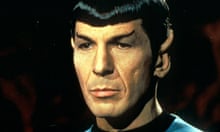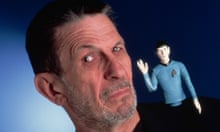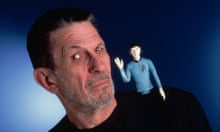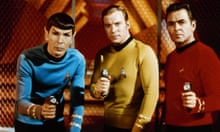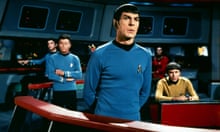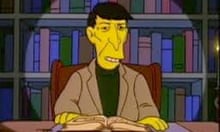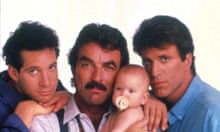Few actors outside soap opera become defined by a single role to the exclusion of all else in their career. But that was the case for Leonard Nimoy, who has died aged 83. He did not simply play Mr Spock, first officer of the USS Enterprise in Star Trek – he was synonymous with him, even after taking on other parts and branching out into directing and photography.
Star Trek began life on television, running for three series between 1966 and 1969, and later spawned numerous spin-offs, including a run of films of varying quality, two of which (Star Trek III: The Search for Spock, from 1984, and Star Trek IV: The Voyage Home, from 1986) Nimoy directed. “I’m very proud of having been connected with the show,” he wrote in 1975. “I felt that it dealt with morality and philosophical questions in a way that many of us would wish were part of the reality of our lives.”
In front of the camera, as the half-human, half-Vulcan Spock, he captured with delicious wit the tensions in the character. Spock’s logical, detached perspective could be infuriating to his more demonstrative colleagues; it also caused him to be amused or bewildered by the workings of humans. This could play out humorously or poignantly. He was uniquely placed, for example, to analyse coolly our emotional shortcomings: “It is curious how often you humans manage to obtain that which you do not want,” he mused in the first series. His dry rapport with the more passionate, full-blooded Captain James T Kirk (William Shatner) was a pleasure that endured long after the Star Trek brand itself showed signs of having been around the galaxy a few too many times.
Once seen, Spock was never forgotten. The hair, boot-polish black, was snipped short with a severe, straight fringe; it looked more like headgear than a haircut, more painted on than grown. An inch of forehead separated that fringe from a pair of sabre-like eyebrows that arched extravagantly upwards. These came in handy for conveying what the reserved Spock could not always express verbally. “The first thing I learned was that a raised eyebrow can be very effective,” said Nimoy.
Spock’s defining physical feature, though, was his pointed ears. The actor’s first reaction upon seeing them was: “If this doesn’t work, it could be a bad joke.” Sharply tapered but in no way pixieish, the ears somehow never undermined his gravitas. Or rather, Nimoy’s sober disposition precluded laughter. Besides, in a show suffused with messages of inclusivity and tolerance, it would never do for audiences to laugh at someone just because he came from Vulcan.
Nimoy contributed key details to the character, including the traditional Vulcan greeting: a hand held up and the four fingers parted to create a V. This was inspired by prayer gestures witnessed by the young Nimoy at synagogue.
He would later title his 1975 memoir I Am Not Spock. “I was trying to illuminate the actor’s process in creating a character. I talked about the fact that I grew up in Boston and Spock did not. My parents were Russian immigrants; Spock’s were not. I’m an actor who portrays this character.” He conceded, though, that the title had been a mistake and had given the erroneous impression that he was trying to shrug off his best-known role. He made amends by calling the 1995 follow-up I Am Spock.
Nimoy was born in Boston, Massachusetts, to Max, a barber, and Dora, and showed an interest in acting from a young age (though his father tried to persuade him to take up the accordion instead). He studied drama at Boston College and began to get small parts in theatre, film and television. At 20 he was cast in the lead role of a young boxer in the 1952 film Kid Monk Baroni, and discovered a kind of sanctuary in the prosthetics he was required to wear. “I found a home behind that makeup,” he wrote in I Am Not Spock. “I was much more confident and comfortable than I would have been, had I been told I was to play ‘a handsome young man’.”
Nimoy did military service from 1953 to 1955, during which time one of his duties was producing army talent shows. He continued acting after leaving the army and in the early 1960s began teaching acting classes, while also starring in guest roles on television series including Bonanza, Rawhide and The Twilight Zone. He established his own acting studio where he taught for three years.
Nimoy auditioned for an earlier Gene Roddenberry project, and when Roddenberry created Star Trek he thought of him for the role of Spock. “I thought it would be a challenge,” Nimoy said. “As an actor, my training had been in how to use my emotions, and here was a character who had them all locked up.”
After 79 episodes across three series, the NBC network cancelled the show because of its low ratings. Nimoy went straight into another regular gig – a role on the light-hearted spy series Mission: Impossible – and then began studying photography at the University of California, Los Angeles. He would later publish photographic studies including Shekhina (2002), a celebration of spirituality and sexuality in Judaism, and The Full Body Project (2007), focused on unorthodox female body sizes.
His acting work in the 1970s included a chilling performance in Philip Kaufman’s intelligent 1978 remake of Invasion of the Body Snatchers. In 1979, he returned to play Spock in the rather leaden Star Trek: The Motion Picture. He would do so in a further seven Star Trek films. Among them were Star Trek II: The Wrath of Khan (1982), Star Trek V: The Final Frontier (1989) and Star Trek VI: The Undiscovered Country (1991). He was the only original cast member to appear in JJ Abrams’s instalments of the revived or “rebooted” franchise, Star Trek (2009) and Star Trek Into Darkness (2013). His appearance in the first of those Abrams films, as the older Spock coming face to face with his younger self (Zachary Quinto), was deeply affecting and played with characteristic restraint. He also revived Spock in two 1991 episodes (“Unification I” and “Unification II”) of the television series Star Trek: The Next Generation, and in animated and computer-game incarnations of Star Trek.
If Nimoy never escaped association with Spock, it was not for want of trying. He wrote seven poetry collections, released several albums and established himself as a successful and varied director. Alongside his two Star Trek movies, he directed himself in a TV movie version of the one-man play Vincent (1981), about the life of Van Gogh. He scored an international box-office hit with 3 Men and a Baby (1987). He also made the drama The Good Mother (1988), starring Diane Keaton and Liam Neeson, as well as two disappointing comedies, Funny About Love (1990) and Holy Matrimony (1994).
He is survived by his second wife, Susan Bay, and by two children, Adam and Julie, from his first marriage, to Sandi Zober, which ended in divorce.
